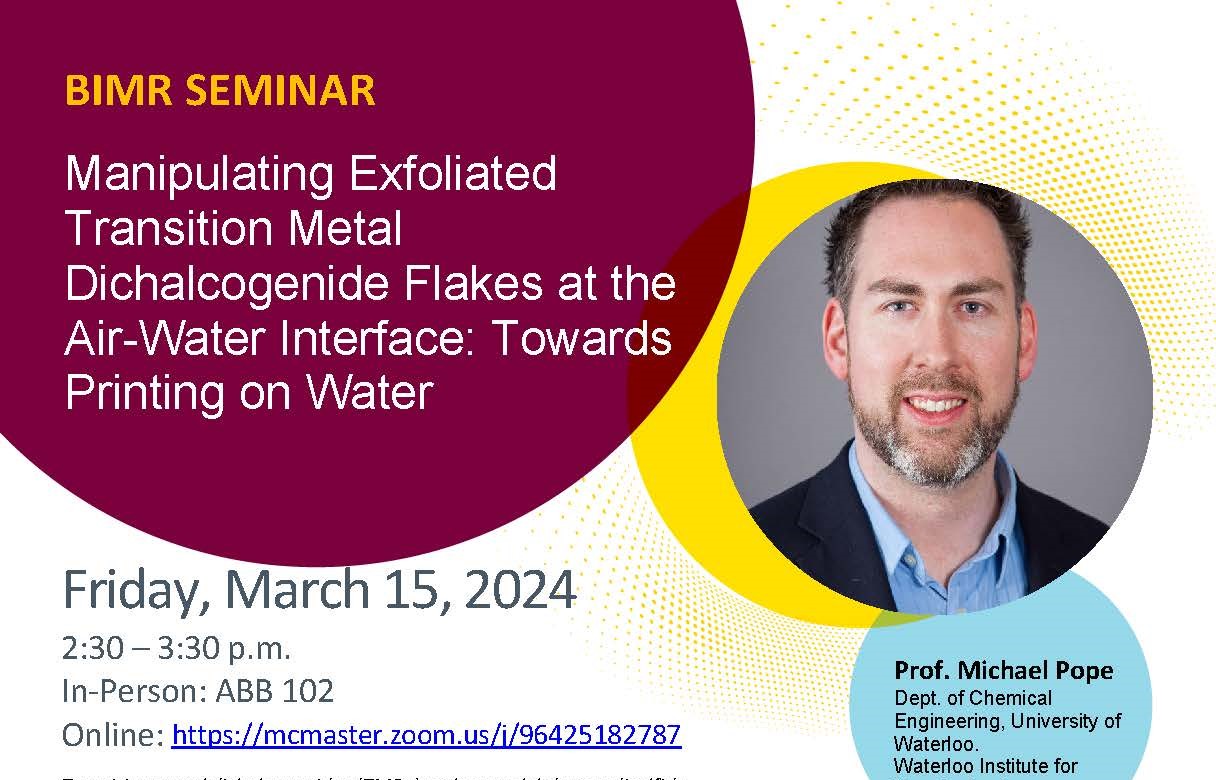Manipulating Exfoliated Transition Metal Dichalcogenide Flakes at the Air-Water Interface: Towards Printing on Water
Mar 15, 2024
2:30PM to 3:30PM

Date/Time
Date(s) - 15/03/2024
2:30 pm - 3:30 pm
Categories
Prof. Michael Pope
Dept. of Chemical Engineering, University of Waterloo.
Waterloo Institute for Nanotechnology
Transition metal dichalcogenides (TMDs) such as molybdenum disulfide (MoS2) exhibit significant layer-dependent changes to their optoelectronic properties. For example, MoS2 exhibits an indirect to direct bandgap transition upon thinning to a single layer which, combined with its high mobility and large absorption co-efficient making it a promising material for future transistors and photodetectors. In particular, exfoliating bulk TMD powders has the potential to produce inks which can be used for coating or printing on arbitrary substrates for applciations such as flexible or wearable electronics. Conventional printing or casting approaches involving colloidal dispersions of 2D materials cannot typically yield films or prints less than 0.1 to 1 micron in thickness. On the other hand, the Langmuir-Blodgett approach can create single molecule thick films since the dispersed material is transferred or printed onto water and even after solvent evaporation, the dispersed phase or pigment remains mobile on the liquid water substrate. This mobility allows the floating material to be compressed by the moveable barriers of a Langmuir-Blodgett trough. However, this mechanical approach limits coatings to small areas (~cm2) and is not amenable to roll-to-roll, high throughput processing. In this talk, I will summarize various works from my group that aim to understand how to use this interfacial mobility to adapt the Langmuir-Blodgett approach to one capable of printing and patterning continuously and over large areas. Since the film quality relies heavily on the ability to produce and process TMD flakes with suitable properties, I will also discuss our work related to the development of stable dispersions of chemically reduced MoS2 and the development of more scalable electrochemical exfoliation approaches that yield thin, large diameter flakes.
Bio:
Prof. Pope is an Associate Professor in the Department of Chemical Engineering at the University of Waterloo (UW) and a member of the Waterloo Institute for Nanotechnology. He is a McMaster alumnus who went on to complete his PhD studies at Princeton University where he studied the production and processing of graphene-based materials into advanced batteries and supercapacitors. After working for two years as a research scientist at one of the world’s first graphene companies, US-based Vorbeck Materials, he joined UW and started the 2D Materials & Electrochemistry Group. His research focus is on improving large-scale exfoliation approaches and developing improved processing and integration strategies to incorporate exfoliated 2D materials into devices ranging from batteries to optoelectronics. Pope is the co-lead of an international research graduate training program entitled “Scalable 2D-Materials Architectures” or 2D-MATURE involving 19 co-PIs across Canada and Germany. He is also co-lead for the recently funded Ontario Battery and Electrochemisty-research Centre that houses infrastructure such as a battery prototyping lab dedicated to helping scale current and next-generation rechargeable battery technologies.
In-Person: ABB 102
Online: https://mcmaster.zoom.us/j/96425182787
Meeting ID: 964 2518 2787
Passcode: 624111

